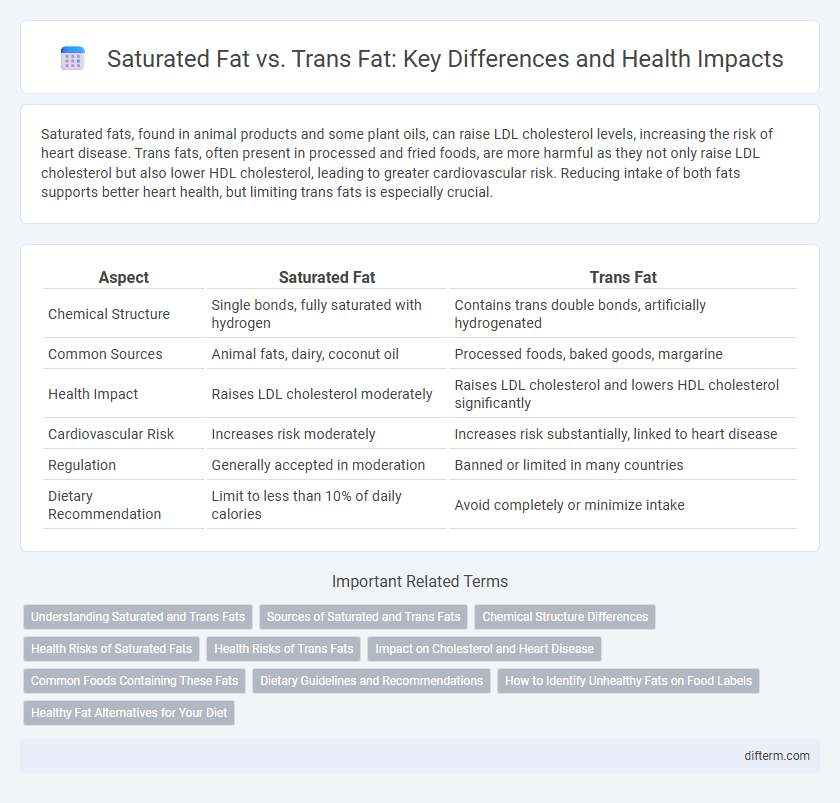Saturated fats, found in animal products and some plant oils, can raise LDL cholesterol levels, increasing the risk of heart disease. Trans fats, often present in processed and fried foods, are more harmful as they not only raise LDL cholesterol but also lower HDL cholesterol, leading to greater cardiovascular risk. Reducing intake of both fats supports better heart health, but limiting trans fats is especially crucial.
Table of Comparison
| Aspect | Saturated Fat | Trans Fat |
|---|---|---|
| Chemical Structure | Single bonds, fully saturated with hydrogen | Contains trans double bonds, artificially hydrogenated |
| Common Sources | Animal fats, dairy, coconut oil | Processed foods, baked goods, margarine |
| Health Impact | Raises LDL cholesterol moderately | Raises LDL cholesterol and lowers HDL cholesterol significantly |
| Cardiovascular Risk | Increases risk moderately | Increases risk substantially, linked to heart disease |
| Regulation | Generally accepted in moderation | Banned or limited in many countries |
| Dietary Recommendation | Limit to less than 10% of daily calories | Avoid completely or minimize intake |
Understanding Saturated and Trans Fats
Saturated fats, primarily found in animal products like butter, cheese, and red meat, raise LDL cholesterol levels, increasing the risk of heart disease. Trans fats, commonly present in partially hydrogenated oils and processed foods, not only raise LDL cholesterol but also lower HDL cholesterol, posing a greater threat to cardiovascular health. Understanding the distinct metabolic impacts of saturated and trans fats is crucial for making informed dietary choices that promote heart health.
Sources of Saturated and Trans Fats
Saturated fats primarily come from animal-based sources such as fatty cuts of meat, butter, cheese, and whole milk, as well as some tropical oils like coconut and palm oil. Trans fats are mainly found in partially hydrogenated vegetable oils used in processed foods, baked goods, fried foods, and margarine. Identifying the sources of these fats is crucial for managing their intake and reducing the risk of cardiovascular disease.
Chemical Structure Differences
Saturated fats contain single bonds between carbon atoms, creating a straight chain that allows molecules to pack tightly, resulting in a solid state at room temperature. Trans fats have at least one double bond in a trans configuration, causing a straighter molecular structure compared to the bent cis configuration in unsaturated fats, which leads to higher stability and a longer shelf life. The unique chemical arrangement of trans fats negatively impacts cardiovascular health by raising LDL cholesterol and lowering HDL cholesterol levels.
Health Risks of Saturated Fats
Saturated fats increase LDL cholesterol levels, which significantly raises the risk of cardiovascular diseases such as heart attacks and strokes. Consuming high amounts of saturated fats can promote inflammation and insulin resistance, contributing to type 2 diabetes development. Replacing saturated fats with healthier unsaturated fats has been shown to improve heart health and reduce overall mortality risk.
Health Risks of Trans Fats
Trans fats significantly increase the risk of heart disease by raising LDL cholesterol and lowering HDL cholesterol levels, contributing to arterial inflammation and plaque buildup. Unlike saturated fats, trans fats also elevate the likelihood of insulin resistance and type 2 diabetes. Consuming trans fats is strongly linked to higher rates of stroke and adverse effects on overall cardiovascular health.
Impact on Cholesterol and Heart Disease
Saturated fat raises LDL cholesterol, which can increase the risk of developing heart disease, while trans fat not only raises LDL cholesterol but also lowers HDL cholesterol, leading to a more harmful impact on cardiovascular health. Trans fats are associated with a higher incidence of inflammation, arterial plaque buildup, and increased risk of heart attacks compared to saturated fats. Reducing intake of trans fats is crucial for maintaining healthy cholesterol levels and preventing heart disease.
Common Foods Containing These Fats
Common foods containing saturated fats include butter, cheese, red meat, and coconut oil, which contribute to increased LDL cholesterol levels and cardiovascular risk. Trans fats are primarily found in partially hydrogenated oils, baked goods like pastries, cookies, and margarine, linked to inflammation and higher heart disease risk. Understanding the sources and health impacts of saturated and trans fats is essential for making informed dietary choices and improving heart health.
Dietary Guidelines and Recommendations
Dietary guidelines recommend limiting saturated fat intake to less than 10% of daily calories to reduce the risk of cardiovascular disease, while trans fats should be minimized as much as possible due to their strong association with increased LDL cholesterol and heart disease. The American Heart Association advises replacing saturated fats with unsaturated fats, such as those found in nuts, seeds, and fish, for better heart health. Trans fats, often found in partially hydrogenated oils, are banned or strongly restricted in many countries because of their detrimental effects on lipid profiles and overall cardiovascular risk.
How to Identify Unhealthy Fats on Food Labels
Unhealthy fats like saturated fat and trans fat can be identified on food labels by checking the Nutrition Facts panel for the amount per serving, with trans fats ideally being zero. Ingredient lists that include partially hydrogenated oils indicate the presence of trans fats, which are harmful even in small amounts. Saturated fats, often found in animal products and some tropical oils, should be limited to reduce the risk of heart disease.
Healthy Fat Alternatives for Your Diet
Replacing saturated and trans fats with healthier fat alternatives such as monounsaturated fats from olive oil, avocados, and nuts, or polyunsaturated fats found in fatty fish and flaxseeds, supports heart health by reducing LDL cholesterol and inflammation. Incorporating omega-3 fatty acids from sources like salmon and chia seeds promotes cardiovascular function and cognitive benefits. Choosing these nutrient-dense fats over processed trans fats and high-saturated fat foods improves overall lipid profiles and lowers the risk of chronic diseases.
Saturated Fat vs Trans Fat Infographic

 difterm.com
difterm.com